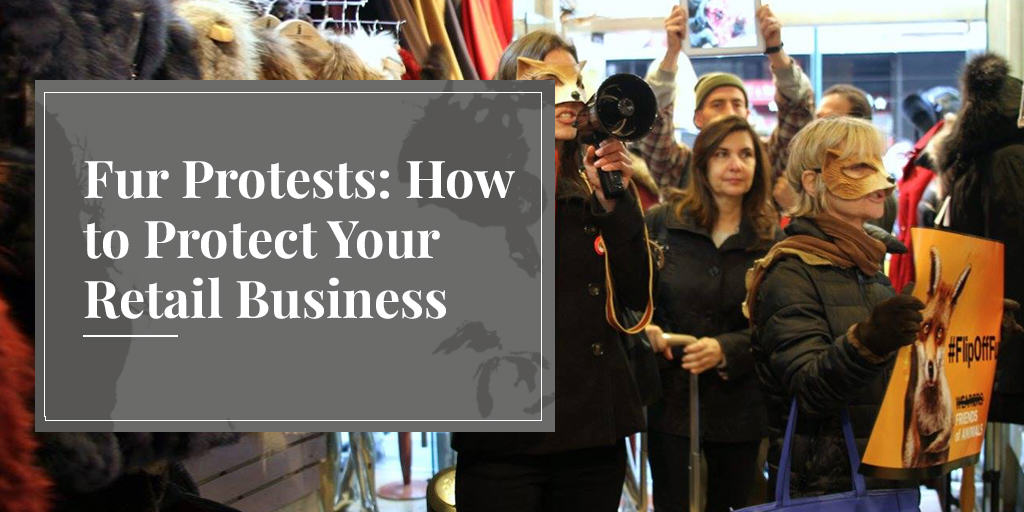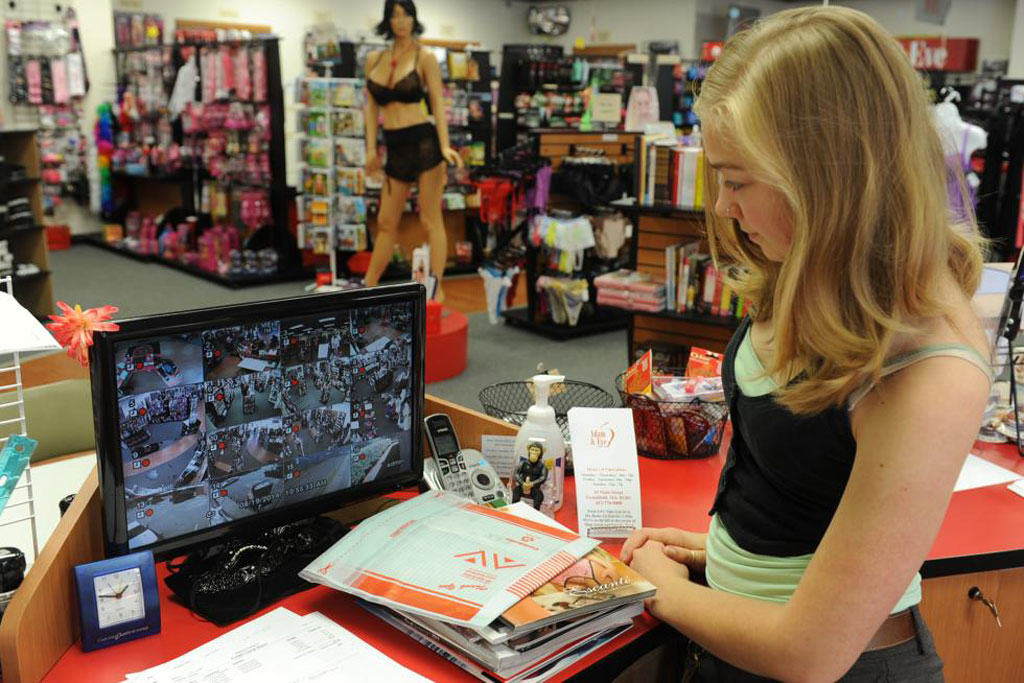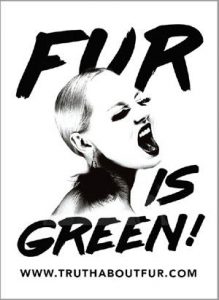
The fur retailing season is beginning, and with it we can expect the usual flurry of fur protests. Despite decades of anti-fur campaigning, activists have generally failed in their efforts to push designers and consumers away from using and wearing nature’s most beautiful clothing material. Fur has probably never been featured in so many top designer runway collections, and fur has certainly never been used in a wider variety of products, from apparel to accessories to home furnishings.
But animal rights activists are not very interested in opinions that differ from their own, so the fur protests continue.
Sometimes, consumers are harassed and retailers are warned that their stores will be targets until they stop selling fur. (Can you spell Protection Racket?) A favourite new tactic is the store invasion (often called Direct Action Everywhere or DxE) where activists enter a shop, individually, posing as consumers, and then pull out posters and begin chanting slogans in unison. One or more protesters film the “action”, taunting shop owners and security staff who dare not push them towards the exit for fear of being slapped with assault charges. Another nasty new trick is to flood a retailer’s Facebook page with negative comments and reviews.

Following are some ways to protect your retail business from animal rights protests.
1. Use Early-Warning Systems
While fur protests can happen any time – especially during the fur season – the next big activist target date is “Fur Free Friday” (the activist response to “Black Friday”), which falls on November 24 this year. Google “Fur Free Friday 2017” to see if your town is listed. Or monitor the national Facebook page.
There are many ways to find out about protests that may be planned for your store. Animal rights groups are often headquartered on university or college campuses, and they find many of their foot soldiers there. So monitor university bulletin boards. It’s even better if someone you know can join the local animal-rights group. Or simply keep an eye on the Facebook page of your local animal-rights group.
Not least important, your national fur trade association can provide a timely heads-up when trouble is brewing, or advice and assistance if your store becomes a target. Be sure you are a paid-up member of the Fur Information Council of America (323.782.1700; [email protected]), or the Fur Council of Canada (514-844-1945; [email protected]). They need your support so they can be there to support you!
2. Build Relations with Local Law Enforcement … and Others
It is always best to build your relationship with local police before you need their help. It can be as simple as calling your local precinct and asking for a meeting with a commanding officer. Or speak with officers who patrol your street. Explain your concern that stores selling fur are often targets for protests or vandalism. Getting to know your local police can play big dividends: they can often warn you of up-coming protests, or keep an eye on your store at night, especially in the period before and after fur protests, a time when vandalism often occurs.

Not least important, police can be present during demos, to tone down rowdy demonstrators and ensure that consumers can access your store without being harassed. While police cannot “take sides”, they do have a mandate to keep the peace and prevent harassment or confrontation, which allows them to keep protesters a certain distance from your door. How they interpret this mandate often depends on what sort of relationship you have developed beforehand.
Remember always to file a police report about any harassment, threats, graffiti or other vandalism, no matter how minor. Take photos before scraping away graffiti from store windows or walls. And keep any threatening phone messages. Such incidents often precede more significant attacks. And these reports allow police to see patterns of radical activism developing, or to make a case with their commanding officers for devoting scarce resources to protecting your store.
You should also build bridges with your local business group or Chamber of Commerce, and with local politicians. Their support can help to ensure that the police will be there when you need them.
3. Secure Your Store
Most fur stores have good security systems to prevent break-ins and theft – insurance companies require them – but be sure you have security cameras and that they are functioning! Cameras surveying the inside of the store can help to identify protesters who enter your premises. Cameras facing the sidewalk can discourage vandalism.

One particularly nasty activist weapon is Butyric acid, a carboxylic acid that has an extremely powerful and unpleasant vomit-like odour. When sprayed under the doors of a store, at night, fur coats can be effectively ruined, as the smell is nearly impossible to remove. The best solution is prevention: ensure that there Is no way to spray anything under your doors or through keyholes or mail slots!
4. Prepare Yourself and Your Staff
Plan and discuss the procedures you will employ if there is a protest at your store. As a general policy, do not engage or argue with protesters; confrontation will only encourage them and could make the protest more “newsworthy” if any media are present. Never touch or push protesters.
Some retailers have rented large cube vans to park in front of their stores, blocking the protesters from the view of passing cars or pedestrians on the opposite sidewalk.
If you know in advance about a protest, consider hiring professional security: they have the knowledge and experience to handle protesters lawfully and effectively.
If you are subjected to repeated or abusive fur protests, you should consult a lawyer: there is a considerable body of labour law relating to the legal limits of picketing.
5. During Fur Protests
It is rare that protesters try to enter stand-alone stores (DxE invasions usually target shops in malls), but if they do, ask them to leave, and call the police. Do not try to expel protesters physically; it is very likely that you are being filmed, and any physical contact could result in criminal charges.
It can be useful to have someone photograph the fur protesters, for identification if needed, and to let them know they are being watched. But check first to ensure that this is legal in your town. And remember rule number one: you do not want to escalate tensions or provoke violence. It is usually better to suffer through the occasional fur protest quietly, rather than make yourself a target for more protests.
For those who would like to respond more actively, the Retail Fur Council of Canada has produced a new tool for retailers to use if they are subjected to a DxE store invasion. Click on the posters below to download, then print them out and hold them up behind chanting protesters or in front of their cameras, or display them in store windows during fur protests. Messages include: “Say NO to extremists” and “Defend freedom of choice!” Such tools should be used with caution, though; you do not want to escalate tensions or make yourself more of a target.



6. Dealing with Media
Media now usually ignore fur protests, especially in larger cities. If journalists do ask you to comment, it is usually best to refer them to your national association (FICA or the FCC). Your association professionals are trained and better prepared to speak with the media … and they have no street-level store windows to break.
If you do want to say something, keep it simple and positive, and then suggest that the journalist contact your national association for more information.
Here are some examples of the type of media statement you can make:
- “If someone does not want to wear fur or leather, or eat meat, that’s their choice. But most people in our society think we do have a right to use animal products, so long as this is done responsibly — as fur is. If you want to know more about that, you should speak with our national association; I will give you their coordinates.”
- “Everyone has a right to their opinions, but our business is doing very well. We are very proud to offer our customers high-quality and sustainably-produced natural products like fur. If you want to know more about that …”
- “If our store is thriving after so many years, it is because there are many people who appreciate the beauty of natural clothing materials. Sure there are synthetic alternatives, but most are made from petroleum, which is not really better for animals or the environment. If you want more information about how fur is produced …”
7. Dealing with Cyber-Attacks
Several North American retailers have recently been hit with cyber-attacks where their Facebook pages are flooded with negative comments and ratings.

If this happens, here are some things you can do:
- Contact Facebook immediately and ask them to remove the abusive (and fake) ratings/reviews. Go to Facebook’s Help Centre here, and follow the menu items Policies and Reporting / Reporting Abuse.
- Tell them this is an orchestrated terrorist-type cyber-attack; tell them you feel threatened.
- If you advertise with Facebook, tell them you will stop advertising if they cannot remove these abusive posts/ratings quickly. (It works!)
- If Facebook does not respond quickly, contact [email protected]; as a stop-gap measure we can rally supporters for positive posts.
- The simplest and quickest solution of all is simply to disable the ratings and comments section of your Facebook page.
Finally, remember: It is always best to be prepared, but most fur protests are brief and relatively harmless. The most important thing is to remain calm and not be suckered into escalating the tension. If you learn that you will be targeted by a fur protest, contact your national association – they have the experience to help you get through these frustrating episodes.
Do you have any other ideas or experiences you would like to share? We would love to hear from you!











Digusting how the consumers “right of choice” is defended but no one takes into consideration the opinion of the abused animals. You wouldn’t respect someone elses choice to harm you.
Hi just opened a magazine dated August 3…to find a model for Moschino….during the latest fashion show for Jeans…wearing a dead fox draped around her neck…How disappointing!!!!
Are you sure it was real? Moschino’s chief creative designer, Jeremy Scott, told WWD in 2018 that he quit using real fur and is a fan of fake fur. https://wwd.com/fashion-news/fashion-features/the-fur-debate-what-designers-say-1202648059/ Maybe it was just a vintage piece being used as a prop.
I would like to see a poster that says “Tell animal rights nuts to stop skinning animals alive!”
https://furcommission.com/saving-society-from-animal-snuff-films/